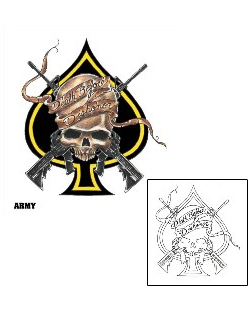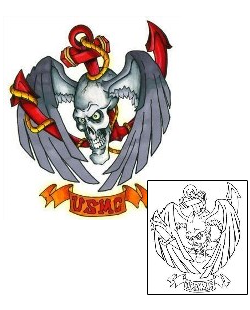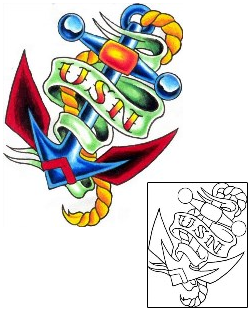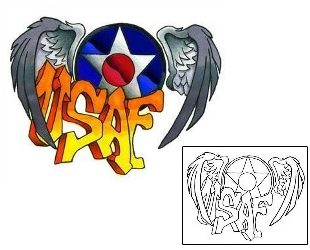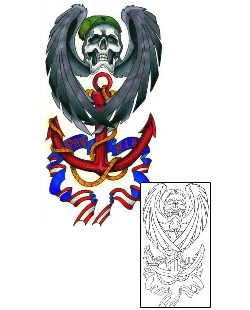Ever since the United States military was founded in 1775, military tattoos have been an integral part of the brotherhood that unites all branches of the military. Tattoos are not only a means of expressing individuality, but they are also a means of identification and even a rite of passage for many members of the military. For military men and women in particular, tattoos are a particularly personal way of taking pride in service and dealing with the emotions of anger and loss that inevitably accompany military service as a portion of one's comrades ultimately meet their demise in service of their country.
Military tattoos can commemorate your own service or someone else's. However, in order to show the proper respect for the sacrifice and bravery of the person that you are commemorating, you should make sure that any badges or other insignia are properly portrayed and that if you did not earn the award yourself, you clearly indicate the source for the tattoo. Recent studies show that tattoos are most common in the Navy, followed by the Army and the Marines. However, marines are most likely of any group to have a tattoo; their numbers are just smaller overall than those of the other military divisions. The Air Force comes in a distant fourth.
In the army, the most popular tattoos are replicas of unit patches, awards or medals. These are not only a great way to internalize your achievement and keep it with you always as a motivational tool and a discreet way to let people know about your hard work and achievements, but they are also symbolic of tours of duty and may be accompanied by dates to commemorate those lost or saved in combat with the soldier bearing the tattoo. In the past decade, meat tags have also become extremely popular. These are tattooed dog tags that permanently display a soldier's information. Many members of the military get these as they prepare to go overseas for their first deployment and say goodbye to friends and loved ones. Of course, these tags also are a means of identifying a soldier even if he or she has lost all other distinguishing marks.
The marines take great pride in their reputation as the toughest, deadliest and fastest striking force in the army. As a result, marine tattoos are frequently similar in nature and intended to help fellow marines identify each other in the civilian world on sight. Often, entire units will go to get tattooed together, selecting a particular format for the marine bulldog tattoo, a unit patch or a distinct tribal band paired with a mutually selected saying or the popular USMC (United States Marine Corp). The Marine Corp seal is also an extremely popular tattoo in this military division. Marine tattoos are probably the easiest for a civilian to identify because they are nearly always similar in nature even if the marines got them at very different times.
It is not surprising that the Navy has the highest percentage of tattooed members, given that sailors have been getting tattoos since time im memorial. However, navy tattoos are the most diverse of all the groups, largely because members of the navy get many different tattoos in many different styles and using a wide variety of tattooing techniques to commemorate their travels throughout the world. In fact, many navy members follow an old sailor's tradition and get a swallow tattoo each time they complete a full trip around the world, which can lead to quite a flock if they are on active duty! Common navy tattoos include anchor tattoos, pinup tattoos and sailor cap tattoos. These tattoos also may have been applied in many different ways, including with bamboo, bone needles or more modern, conventional tattoo guns.
Finally, U.S. Air Force members also have their own brand of tattoos, which include pilot wings tattoos, eagle tattoos, airplane and fighter jet tattoos and a variety of unit patches. However, in the Air Force, the regulations on tattoo placement are much stricter than in other branches of the military, and often officers are very careful to keep tattoos in areas that are out of sight even when they are in civilian clothing. Naturally, this also results in a far lower overall number of documented trends in U.S. Air Force tattoos.
Military tattoos are not only for those that are in the military, but also for those who wish to express admiration or memorialize a family member or close friend who served their country. Common themes for memorial tattoos are portrait tattoos, dates of service, birth and death dates, or name tattoos that are then accompanied with a military tattoo or a common military saying. For example, many people get tattoos with a loved one's name, accompanied by the popular expression, "freedom is not free." Also, many Vietnam veterans in particular -- and their relatives -- bear POW/MIA tattoos that indicate that they have not forgotten the prisoners of war and soldiers who are still missing in action from that turbulent and traumatic time in U.S. military history.
As the United States once again asserts its military presence on a public and global scale, the popularity of military tattoos is on the rise. A military tattoo or a patriotic tattoo, such as that of a flag, a meaningful monument, or the silhouette of the Twin Towers can demonstrate one's commitment to one's country and the military's cause regardless of whether or not you qualify to serve. Yellow ribbon tattoos, camouflage ribbon tattoos and red, white and blue ribbon tattoos are also becoming increasingly prevalent among the civilian population as those left at home seek to celebrate and commemorate their loved ones serving abroad. Regardless of the reason that you want to get a military tattoo, these permanent designations about your identity and the country that you love should always be treated with honor, respect and dignity. Whether you just support the soldiers or you champion their cause as well, military tattoos can help you display just how proud you are of your service and your country.
Show me more Patronage Tattoo Designs


